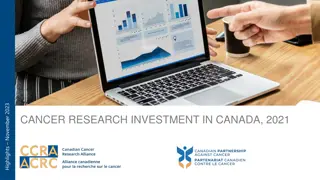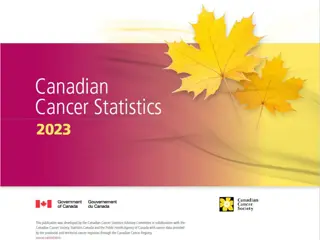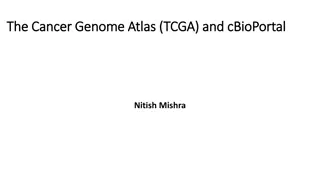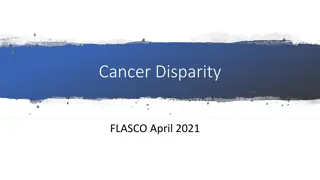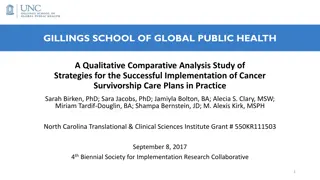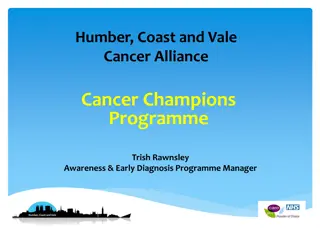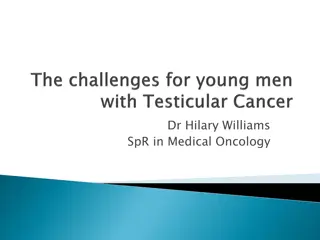Canada's Investment in Cancer Survivorship Research, 2005-2016 Highlights
The Canadian Cancer Research Alliance (CCRA) collaborates with various organizations to fund cancer research in Canada, focusing on prevention, diagnosis, treatment, and improving survivor outcomes. The CCRA is supported by the Canadian Partnership Against Cancer to implement strategies for cancer control and research. An analysis of research investment in cancer survivorship was conducted from 2005 to 2016, aiming to track progress and identify priority areas for research. Methodology involved reviewing over 22,000 research projects, with a final sample of 1,660 projects categorized based on study population, research focus, and type. Investment in research projects was based on prorated calculations.
Download Presentation

Please find below an Image/Link to download the presentation.
The content on the website is provided AS IS for your information and personal use only. It may not be sold, licensed, or shared on other websites without obtaining consent from the author.If you encounter any issues during the download, it is possible that the publisher has removed the file from their server.
You are allowed to download the files provided on this website for personal or commercial use, subject to the condition that they are used lawfully. All files are the property of their respective owners.
The content on the website is provided AS IS for your information and personal use only. It may not be sold, licensed, or shared on other websites without obtaining consent from the author.
E N D
Presentation Transcript
1 CANADA S INVESTMENT IN CANCER SURVIVORSHIP RESEARCH, 2005 2016 Highlights March 2019
2 INTRODUCTION The CCRA is an alliance of organizations that collectively fund most of the cancer research conducted in Canada research that will lead to better ways to prevent, diagnose, and treat cancer and improve survivor outcomes. Members include federal research funding programs/agencies, provincial research agencies, provincial cancer care agencies, cancer charities, and other voluntary associations. Member are motivated by the belief that, through effective collaboration, Canadian cancer research funding organizations can maximize their collective impact on cancer control and accelerate discovery for the ultimate benefit of Canadians affected by cancer. The Executive Office is supported by the Canadian Partnership Against Cancer, funded by Health Canada to work with Canada s cancer community to implement the Canadian Strategy for Cancer Control to reduce the incidence of cancer, lessen the likelihood of Canadians dying from cancer, and enhance the quality of life of those affected by cancer. The Partnership is committed to enhancing the cancer research environment in Canada through its support of the CCRA and CCRA s role in coordinating the cancer research funding system. As a member and funder of the CCRA, the Partnership collaborates with other member organizations to enable the strategy for cancer research in Canada. Canadian Cancer Research Alliance
3 WHY REPORT ON THIS INVESTMENT? An initial analysis on the investment in research on cancer survivorship that was done for the 2005 to 2008 time period. Until that time, no broad scale study of investment in cancer survivorship research in Canada existed. As part of Target 2020, a pan-Canadian research framework for cancer survivorship research was released in 2017 to identify priority areas for research and ways to facilitate knowledge translation. Tracking progress towards these priorities is important. By 2020, it is estimated that there will be close to two million cancer survivors in Canada. Canadian Cancer Research Alliance
4 METHODOLOGY The Canadian Cancer Research Survey (CCRS) was the primary data source. This is a database of over 22,000 research projects funded by 42 governmental and voluntary sector organizations for years 2005 to 2016. 3,163 projects coded entirely to CSO category 6 Cancer Control, Survivorship and Outcomes Research, which includes patient care and survivorship code, were reviewed and either excluded or included as part of the study sample. The final sample consisted of 1,660 projects and these were coded on three dimensions: study population, research focus, and research type. Cancer research investment refers to the direct funding of research projects that were administered by organizations contributing data to the survey. All projects had received some form of peer review. Institutional affiliation of the nominated principal investigator (PI) was used for analyses based on geography (province). Canadian Cancer Research Alliance
5 CANCER SURVIVORSHIP RESEARCH CLASSIFICATION Canadian Cancer Research Alliance
6 REPORTING CONVENTIONS Investment for each project was based on a prorated calculation that assumes project dollars were paid out in equal monthly instalments in accordance with project start and end dates. Project funding was calculated for the period January 1, 2005 to December 31, 2016, and averaged to yield an annual amount. Project budgets were weighted to reflect the extent of relevance to cancer survivorship. Canadian Cancer Research Alliance
7 CAVEATS There may be relevant research undertaken by cancer organizations and non-cancer organizations that do not participate in the CCRS. We expect this is the case, but cannot quantify the magnitude of this investment. Investment figures for British Columbia may under-represent the investment in cancer survivorship research for the province because the BC Cancer Agency and its Foundation do not contribute data to the CCRS. Canadian Cancer Research Alliance
8 A. OVERALL INVESTMENT Over the twelve years, $211.1M was invested in cancer survivorship research and this represented 3.6% of the overall cancer research investment. The investment climbed steadily from 2005 to 2015, dipping slightly in 2016 to $23.6M, and the proportion of the investment from targeted program also dipped in 2016. 21% of the total cancer survivorship research investment in 2013 16 was focused on children and adolescents, a growing percentage. As a collective, organizations within the federal government represented 46% of the cancer survivorship investment regardless of the time period. In 2013 16, organizations within the voluntary sector accounted for 38% of the cancer survivorship research investment and this was proportionately higher than that found for the overall cancer research investment. Canadian Cancer Research Alliance
9 ANNUAL INVESTMENT, 2005 2016 ($M) 30 24.4 25 23.6 22.7 20.6 19.6 31% 28% 20 Investment from targeted programs 31% 16.9 16.7 26% 27% 15.6 15.1 18% 19% 15 13.6 10% Other investment 12% 11.2 16% 10.9 16% 11% 10 Total annual investment 72% 69% 69% 74% 73% 90% 82% 81% 88% 84% 5 89% 84% 0 2005 2006 2007 2008 2009 2010 2011 2012 2013 2014 2015 2016 Canadian Cancer Research Alliance
10 INVESTMENT BY TARGET POPULATION, THREE PERIODS (%) 2013 16 2009 12 2005 08 0 10 20 30 40 50 60 70 80 90 100 Focus on child and adolescent patients Focus family members/caregivers of child and adolescent patients Focus on patients of other ages Canadian Cancer Research Alliance
11 CANCER SURVIVORSHIP RESEARCH INVESTMENT AND TOTAL CANCER RESEARCH INVESTMENT BY FUNDING SECTOR, THREE PERIODS (%) 0 10 20 30 40 50 60 70 80 90 100 Cancer survivorship research 2005 08 46 18 34 2 2009 12 46 17 36 2 2013 16 46 15 38 1 2005 08 46 24 22 8 All cancer research 2009 12 45 25 22 9 2013 16 45 23 26 6 Federal government organizations/programs Provincial government agencies/organizations Charitable organizations/associations Other partnered/leveraged funding Canadian Cancer Research Alliance
12 B. INVESTMENT BY FUNDING ORGANIZATIONS/ PROGRAMS Of the 42 organizations tracked in the CCRS, 39 had some level of investment in cancer survivorship research. Much of the investment (61%), however, was made by three organizations: Canadian Institutes of Health Research (CIHR), Canadian Cancer Society (CCS), and Canadian Breast Cancer Foundation (CBCF). CIHR represented 36% of the cancer survivorship research investment and this investment represented 5% of CIHR s overall cancer research investment. There was $15.6M more invested by CIHR in 2013-16 than in 2005-08. CCS represented 16% and CBCF 9% of the 12-year cancer survivorship research investment. Prostate Cancer Canada had a significant increase in its investment in the 2009 12 period, corresponding to the initiation of its TrueNTH program. Canadian Cancer Research Alliance
13 INVESTMENT BY FUNDING ORGANIZATION [1], 2005 2016 ($M) 2005 2006 2007 2008 2009 2010 2011 2012 2013 2014 2015 2016 4.6 4.5 4.5 4.7 4.8 6.6 CIHR 6.1 7.5 8.2 8.6 8.7 7.8 Prostate Cancer Canada 0.0 0.0 0.0 0.0 0.0 0.0 0.1 0.1 0.3 2.4 3.4 3.9 CCS 2.4 2.7 2.8 2.6 2.6 2.5 2.4 3.4 3.5 3.0 2.7 2.7 CBCF 0.8 0.6 1.2 1.8 2.0 2.2 2.0 2.0 2.1 1.8 1.4 1.3 PHAC 0.2 0.2 0.3 0.4 0.5 0.5 0.7 0.7 0.9 1.2 1.3 1.2 FRQS 0.3 0.4 0.4 0.3 0.3 0.3 0.6 0.8 0.9 0.8 0.9 0.9 Alberta Innovates 0.5 0.8 0.9 1.1 1.2 0.9 0.9 0.6 0.4 0.3 0.4 0.5 Other 2.0 2.1 3.6 4.2 4.2 3.6 4.3 4.5 4.2 4.6 5.6 5.3 [1] The seven organizations with the highest 12-year investments are identified by name. Canadian Cancer Research Alliance
14 C. INVESTMENT BY FUNDING MECHANISM & CANCER SITE Over 12 years, there was a significant rise in the investment in operating grants, although like the overall cancer survivorship research investment, the operating grant investment dipped in 2016. Breast cancer research represented 41% of the site-specific cancer survivorship research over the 12-year period. The largest increased investment from the first to the third time period was found for prostate cancer ($8.6M), breast ($7.7M), leukemias ($5.5M), and oral cancers ($2.3M). Canadian Cancer Research Alliance
15 INVESTMENT BY FUNDING MECHANISM, 2005 2016 ($M) 0 5 10 15 20 25 2005 2006 2007 2008 2009 2010 2011 2012 2013 2014 2015 2016 Operating grants Equipment/infrastructure grants Career awards Trainee awards Related support grants Canadian Cancer Research Alliance
16 INVESTMENT BY CANCER SITE, THREE PERIODS ($M) 0 5 10 15 20 25 2005 08 2009 12 2013 16 Bladder Bone and connective tissue Brain Breast Colorectal Hodgkin lymphoma Kidney Leukemias Lung Non-Hodgkin lymphoma Oral Ovary Pancreas Prostate Canadian Cancer Research Alliance
17 D. INVESTMENT BY RESEARCH FOCUS & TYPE From the first to the third four-year period, there were substantial increases in the investments in physiological effects ($27.8M), care delivery, access and quality ($8.6M), and, to a lesser extent, quality of life ($2.2M). Four types of physiological issues accounted for most of the investment in 2013 16: cardiotoxicity/vascular issues (16%); urinary, sexual and/or reproductive disorders (10%); cognitive and/or neurological issues and neuropathy (10%); and pain (5%). The research investment changed from the first to the third four-year period in terms of type of research. The most significant shifts: $21.6M more was invested in intervention research, $10.5M more in prediction/assessment research and $9.8M more in descriptive research in the 2013 16 period. Canadian Cancer Research Alliance
18 INVESTMENT BY RESEARCH FOCUS, THREE PERIODS (%) 0 10 20 30 40 50 60 70 80 90 100 2005 08 44 18 22 3 3 11 2009 12 49 17 15 2 2 15 1 2013 16 55 11 15 3 1 15 Physiological effects Psychological effects Quality of life Social needs/social support Economic sequelae Care delivery, access and quality Thanatological issues Canadian Cancer Research Alliance
INVESTMENT BY RESEARCH FOCUS, TYPE OF RESEARCH, THREE PERIODS ($M) 2005 08 ($50.9M) 2009 12 ($68.9M) 2013 16 ($91.3M) 19 0 10 20 30 40 50 0 10 20 30 40 50 0 10 20 30 40 50 INVESTMENT BY RESEARCH FOCUS, TYPE OF RESEARCH, THREE PERIODS ($M) Physiological effects 2005 08 ($50.9M) 2009 12 ($68.9M) 2013 16 ($91.3M) 0 10 20 30 40 50 0 10 20 30 40 50 0 10 20 30 40 50 Psychological effects Physiological effects Quality of life Psychological effects Social needs/social support Quality of life Social needs/social support Economic sequelae Economic sequelae Care delivery, access and quality Care delivery, access and quality Model systems Descriptive Model systems Descriptive Intervention Prediction/assessment Prediction/assessment Intervention Knowledge synthesis Other support Other support Knowledge synthesis Canadian Cancer Research Alliance
20 E. NOMINATED PRINCIPAL INVESTIGATORS There were 284 nominated principal investigators (PIs) who received one or more award/grant focused on survivorship over the 12 years. This represented 9% of the total number of cancer researchers. Of the 284 PIs, more than 60% (N=180) had received funding in 2013 16 and they were working at institutions located in eight provinces. Although the vast majority of trainees are supported through operating grants, a small group of trainees do receive awards to facilitate completion of their research training. Of the 278 trainees granted awards over the 12-year period, 16 (6%) went on to receive one or more operating grants, equipment/infrastructure grants, or career awards. Regional investment in trainee awards was highest in the 2013 16 period whereas national investment showed a decrease except for post-doctoral awards. Canadian Cancer Research Alliance
21 NOMINATED PRINCIPAL INVESTIGATORS [1], THREE PERIODS 2013 16 N=180 2009 12 N=180 2005 08 N=125 N=52 Canadian Cancer Research Alliance
22 NOMINATED PRINCIPAL INVESTIGATORS BY PROVINCE, 2013-2016 (N) 0 5 10 15 20 25 30 35 40 45 50 55 60 65 70 75 80 85 B.C. 23 Alta. 23 Sask. 2 Man. 7 Ont. 82 Que. 31 N.B. 4 N.S. 8 Canadian Cancer Research Alliance
23 TRAINEE AWARD INVESTMENT BY PROGRAM REACH AND TYPE, THREE PERIODS ($M) 4.0 2005 08 2009 12 2013 16 3.5 3.0 2.5 2.0 1.5 1.0 0.5 0.0 Undergraduate Graduate Post-doctoral Training program Undergraduate Graduate Post-doctoral National Regional Canadian Cancer Research Alliance
24 FURTHER INFORMATION The brief report, Canada s Investment in Cancer Survivorship Research, 2005 2016, is available at http://www.ccra-acrc.ca. Production of this report was made possible through collaboration and financial support from the Canadian Partnership Against Cancer Corporation and Health Canada. The Pan-Canadian Framework for Cancer Survivorship Research, published in 2017, is also available on our website. The framework identifies priority areas for investment as well as ways to facilitate knowledge translation. This report would not have been possible without the advice provided by Drs. Judy Bray (Canadian Cancer Society), Craig Earle (Canadian Partnership Against Cancer), Stuart Edmonds (Prostate Cancer Canada), Jim Hudson (Consultant), and Stephen Robbins (CIHR Institute of Cancer Research). Questions about this project, should be directed to the Canadian Cancer Research Survey Manager at info@ccra-acrc.ca. Canadian Cancer Research Alliance
www.ccra-acrc.ca @CCRAlliance linkedin.com/company/canadian-cancer-research-alliance/ info@ccra-acrc.ca Canadian Cancer Research Alliance



